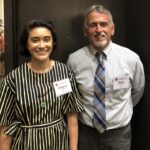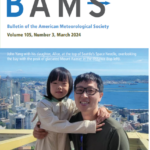Dr. Huan Meng
By Katelyn Newman
Dr. Huan Meng, a NOAA physical scientist and Visiting Associate Research Scientist at the University of Maryland's Cooperative Institute for Climate and Satellites (CICS-MD), received NOAA's 2014 Bronze Medal for her satellite data analysis of snowfall rate, which will help weather forecasters more accurately predict the severity of snowstorms.
The NOAA Bronze Medal is the highest honor awarded by the Under Secretary of Commerce for Oceans and Atmosphere to an individual, group, or organization "for leadership, personal and professional excellence, scientific/engineering achievement, organizational development, customer service, administrative/technical support or heroism."
"Right now my main focus has been on the snowfall retrieval rate through satellite data," said Meng. "It's much easier to retrieve rainfall form satellite measurements- that's been around for decades, and people have done a lot of work in that field- and my snowfall retrieval research has been inspired by that research."
"We are right now improving the product- there is always more to work on being a new field," said Meng. "The reason why it's so new is because it's very complicated. Snowfall is so much more complicated than rainfall- there are a lot of areas that we still need to explore and basically improve on."
"Meng was able to take this challenging science problem and get it into this operational 24 hours, 7 days a week environment," said Ralph Ferraro, Chief of the NOAA Satellite Climate Studies Branch. "Satellites she was using weren't really able to do this kind of work but because of ESSIC, CICS and NASA, we were able to push the science and get some research out."
"We sort of pushed the limits of what our satellites can measure," said Ferraro. "It's been a really successful project that was worthy of the award because it was the first time we were able to do this on an operational basis."
Ferraro, who has worked with Meng for about 15 years, said he enjoys working with her because she is a good scientist, is very professional, gets her work done on time, presents her work well and writes very well.
"She's an up-and-coming scientist within our group at NOAA," said Ferraro.
Dr. Cezar Kongoli, a UMD-ESSIC scientist within CICS, has known and worked with Meng for the past 10 years on snowfall rate using new satellite technologies.
"It's a problem that is extremely challenging, and also as a product this is very useful," said Kongoli. "The existing snowfall method technique has now been able to retrieve or estimate snowfall in very cold conditions."
"We get along very well- we understand each other's style of working, and she is very cooperative, very collaborative- it's been very much about teamwork," said Kongoli.
Meng said that one of the biggest challenges she has had throughout her research on snowfall rate is that there is little to no data to compare with her own.
"We don't have enough data because snow is so complicated- it can change in shape, in size, in density of the snow particles," said Meng. "It varies in space, it keeps growing- there are many factors in the environment that can impact how the snowflakes can form and how it falls."
"We need more data that can help us to define what the snow characteristics are, but we don't have enough measurements," said Meng.
Meng plans to continue her research into snowfall rate, collecting more data through the use of new sensors and observations to more accurately predict snowy weather. In October, Meng said her research group will conduct a second assessment that will blend the product with collected radar precipitation data.
"The more satellite data we use, the more coverage we have," said Meng. "It's very interesting work, being on the front of cutting-edge research."






